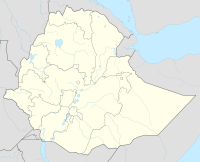Azabo
Approximate location of the Azabo area |
The Azabo ( Oromiffa : Azaboo , Tigrinya ዓዘቦ ʿAzäbo , also transcribed as Azebo ) are together with the Rayya the northernmost subgroup of the Oromo , the numerically largest ethnic group in Ethiopia .
They live on the eastern edge of the highlands in the southeast of the Tigray region , where a woreda raya azebo named after them exists.
history
The Azabo belonged to the Barentuma branch of the Oromo and immigrated to their present-day areas from the south in the course of the Oromo expansion in the 16th century. Historically they are closely related to the Rayya (Raya, Raayyaa), and both groups, according to their traditions, came from Awashgama , "across the Awash River ".
The Azabo traditionally kept cattle and camels. According to Nathaniel Pearce , they practiced their traditional religion in the early 19th century, worshiped the wanza tree as sacred and lived as nomadic ranchers in an extensive, dense forest area and occasionally attacked their neighbors. They later adopted Islam . Despite contacts and intermingling with the Tigray and Amhars living in the highlands , they retained their own ethnic and cultural identity for a long time. In the areas mainly on the edge of the highlands, where the Azabo farmed crops, they adopted the rist land ownership system , which grants far-reaching land rights to farmers belonging to the same ethnic group. The society of the Rayya and Azabo was based on kinship relationships and was much less socially stratified than the feudal societies of the highlands. Mutual attacks and cattle theft occurred for both economic and ritual reasons, as they were initiation rites for young men. Occasionally Rayya and Azabo advanced to Tigray and Enderta (Ǝndärta). At the beginning of the 19th century, Gugsa Märsa led the Azabo and the Yejju-Oromo against Tigray under Wolde Selassie .
From the end of the 19th century, the Ethiopian government tried to bring the Rayya and Azabo under control in order to end their traditional warfare, to control the trade route to Eritrea and the Red Sea and to be able to pay tribute and at times also to convert them to Ethiopian Orthodox Christianity . Yohannes IV sent troops to pillage and destroy villages. Menelik II's troops crossed the area on their way back from the Battle of Adwa in 1896 , where they plundered and slaughtered cattle. During the reign of Zauditu , the Azabo rebelled against the governor of Tigray. In 1928 Ras Gugsa Araya was appointed governor to rule over them, but he failed to establish that rule. In the Italian-Ethiopian War of 1935-36 , Rayya and Azabo supported the attacking Italians against Ethiopia.
After the end of the Italian occupation in 1941, there were again conflicts with the Ethiopian state authorities, which held the Rayya and Azabo responsible for endangering the road from Addis Ababa to Asmara and attacked them in 1942. In 1943 both groups therefore took part in the Woyane Rebellion, in which peasants and part of the Tigray nobility turned against the central government of Haile Selassie . After the uprising, the state expropriated the land of the Rayya and Azabo, which is traditionally the most severe form of punishment in Ethiopia. Much of their area was also transferred from Tigray to the southern neighboring province of Wollo . Rayya and Azabo became landless who had to lease the land they had previously owned. Land conflicts in the area increased sharply. The expropriation contributed to the fact that the Rayya and Azabo were particularly hard hit by the drought and famine of the 1970s.
When in 1991 the administrative structure of Ethiopia was reorganized according to ethnic criteria, the areas of the northernmost Oromo groups were assigned to the regions of Tigray and Amhara . The Oromo Liberation Front unsuccessfully demanded their annexation to the Oromia region .
swell
- ↑ a b c d e Ahmed Hassen Omer: Azaboo , in: Siegbert Uhlig (Ed.): Encyclopaedia Aethiopica , Volume 1, 2003, ISBN 3-447-04746-1
- ↑ a b c d Gebru Tareke: Peasant Resistance in Ethiopia: The Case of Weyane , in: The Journal of African History , Vol. 25, No. 1, 1984, pp. 77-92
- ↑ a b Gebru Tareke: Ethiopia: Power and Protest. Peasant Revolts in the Twentieth Century , Red Sea Press 1996, ISBN 9781569020197
- ↑ Alex de Waal, Africa Watch: Evil Days. 30 Years of War and Famine in Ethiopia , 1991 (pp. 56, 59)
- ↑ Thomas Zitelmann: Nation of the Oromo. Collective identities, national conflicts, we-group formation , 1994, ISBN 9783860930366 (p. 178)
